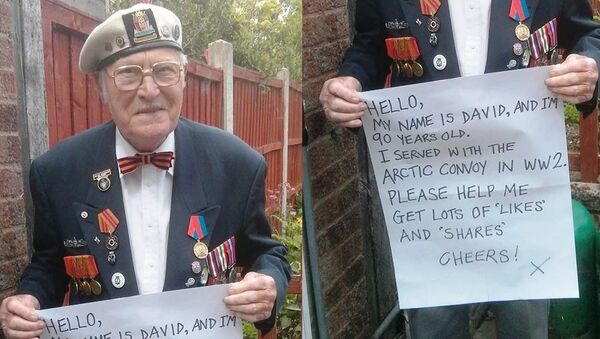Tam's father-in-law is David Kennedy — who served in the Arctic Convoy during World War II — and he accompanied the picture with the words "let's see how many likes and shares we can get for the old fella."
Over 150,000 likes, 45,000 shares and nearly 7000 comments later, Tam said that he was "overwhelmed" by the response to the post.
The photograph features David Kennedy, holding a handwritten message reading: "Hello, my name is David, and I'm 90 years old. I served with the Arctic Convoy in WW2. Please help me get lots of 'likes' and 'shares' Cheers! x"
"I'd seen a number of these sort of things on Facebook, old soldiers or people requesting 'likes' and 'shares' and things, and initially I thought that was a bit rubbish really — fishing for compliments and stuff — but I thought I'd give it a go with my father in law. He's 90 now, and he's quite frail, and he's one of the dwindling band of his comrades — they're a very loyal bunch and there's so few of them now," Tam told Sputnik.
Veterans of #Russian #Arctic Convoys find themselves in archival photos of exhibition at #SimonsTown Naval Museum pic.twitter.com/ZRJ6HjLFPi
— ГК РФ в Кейптауне (@RusConsCapetown) May 16, 2016
By all accounts, his father in law is somewhat bemused by the response, though extremely touched. At 90 years old he's not particularly au fait with the world of social media, but Tam's wife has been reading some of the thousands of comments to him at his home in Cornwall.
Ambassador #Petrakov & SA Navy top officials open "Russian Arctic Convoys 1941-1945" exhibition in #SA Naval Museum pic.twitter.com/RIbNp0jOHk
— Rus Embassy in RSA (@EmbassyofRussia) May 17, 2016
"What amazed us what that people started uploading photographs of their own family members who were also veterans, and all their stories as well. So it's become a bit of a tribute to the whole veteran community," Tam said.
Tam told Sputnik that the point at which the response got "very big" was once it had reached Russia, saying:
"The Russian people idolize these guys from the Arctic convoys."
Celebration of the #VDay in the Northern Scotland — Arctic Convoys Memorial in Lynesshttps://t.co/B1fw7lxWJ2 pic.twitter.com/zzetvtbShj
— Russian CG Edinburgh (@RusCG_Edinburgh) May 18, 2016
He went on to explain that the British veterans of the Arctic Convoy had only very recently been recognized by the UK Government:
"Only three or four years ago did these guys finally get recognized and presented with a medal, from the British Government. The Russians have been fêting them for years with accolades and medals. Because it's taken so long for the British Government to recognize them, a lot of them are dead, and families had to apply retrospectively to get these medals posthumously, it's disgusting."
The Arctic Convoys of World War II played a huge role in the allied campaign to defeat the Nazis, maintaining vital supply links between the UK, Iceland and the US to northern ports in the Soviet Union.
Wreath laying at the Arctic Convoy Memorial at Cove, Loch Ewe on 14th May 2016. pic.twitter.com/BaGt5PlbFq
— Arctic Convoy Museum (@InfoRACM) May 16, 2016
78 convoys ran in total between August 1941 and May 1945, comprised of around 1400 merchant ships escorted by ships from the Royal Navy, Royal Canadian Navy and the US Navy — constituting almost a quarter of the total aid to the USSR during the war.
Arctic convoy PQ17 assembled at Hvalfjord, Iceland (June 1942). #WW2 pic.twitter.com/LLHCXwMMev
— Paul Hamilton (@_PaulHamilton) May 22, 2016
On this day 1941 @RoyalNavy cruisers HMS Norfolk & HMS Suffolk sight German battleship Bismarck &cruiser Prinz Eugen pic.twitter.com/vZpM8Y5d4v
— Dr Phil Weir (@navalhistorian) May 23, 2016
Whilst the Arctic route was the quickest and most direct supply route to the USSR, it was by far the most dangerous and many of those who operated the routes never returned home. This August sees the 75th anniversary of the first of the Arctic Convoys, celebrating the arrival of the 'Dervish' to Arkhangelsk on August 31st 1941.
"Arctic Convoys hold a very special place in our memory. It was an inspiring symbol of the Soviet-British friendship, brotherhood-in-arms forged between our nations during the war. British, Soviet, American vessels brought important supplies to Russia and back or defended the lines from the dangerous and experienced enemy. Our sailors and pilots fought bravely together in the Arctic theatre," Andrey Pritsepov, the Consul General of Russia in Edinburgh told Sputnik.
"I am delighted that people around the globe are aware of what they did and show their respect and admiration to the veterans who fought with great bravery and to those who sacrificed their lives for our joint victory."


